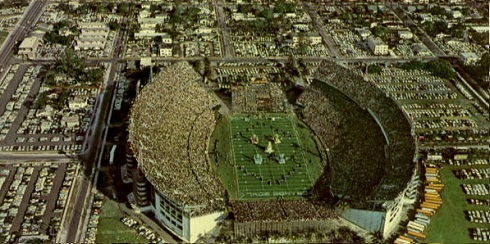ORANGE BOWL
|
|
 |
MIAMI, FL
|
|
Home of the University of Miami Hurricanes for more than 60 years,
the Orange Bowl was the site of many historical football
moments. In the early 1930s, a new stadium was needed for the
University of Miami’s football program. In July 1936, the
Hurricanes and the City of Miami reached an agreement to build a
new stadium for the team. The stadium was completed one year later
at a cost of $340,000. The stadium was originally known as Burdine Stadium
and had a seating capacity of 23,330. The Miami Hurricanes played their
inaugural first game at the stadium on December 10, 1937 against
Georgia. Like many stadiums throughout the country, the Hurricanes
were a huge draw and therefore more seats were needed. In 1944,
the stadium was enclosed when over 10,000 seats were added to the endzones bringing the capacity to 35,030. In 1947, an additional
25,000 seats were added raising the capacity to 60,000. Between
1950 and 1957 roughly 16,000 seats were installed completing the
upper deck of the stadium.
In 1959, Burdine Stadium
was renamed the Orange Bowl. The NFL’s Miami Dolphins played their
first game at the stadium on September 2, 1966. The east end zone
seats were removed in 1977, reducing the capacity to 75,500. By
the 1980s the Dolphins decided they wanted a stadium of their
own. After the 1986 season they moved into Pro Player Stadium.
Expansion of the VIP seating at the Orange Bowl and the addition
of contour seats in the early 1990s reduced the capacity to
74,712. In 1994, construction designed to improve
handicap seating further reduced the capacity. Renovations in 1996
to accommodate Olympic soccer again reduced the capacity to 72,319. Two levels of seats
were in a horseshoe around the
playing field. The stadium was open on one end where the
score/video board is located. It was the home to
many memorable football games including five Super Bowl’s and
eleven National Championship football games. It was the home of the Miami Hurricanes until 2008 when
they moved to Sun Life Stadium. The Orange Bowl was demolished in
2008 and is now the site of Marlins Park, home of the Miami
Marlins (MLB).
|
|
|
|
-Tenant: Miami Dolphins
-Capacity: 72,319
-Surface: Grass
-Opened: September 2, 1966 (NFL)
-Closed: December 22, 1986 (NFL) |
-Other Names: Burdine Stadium
-Cost:
$340,000
-Architect: Unknown
-Demolished: Winter 2008 |
|
|
|
|
|
|
|
Oakland Raiders vs
Green Bay Packers
January 14, 1968
FINAL SCORE:
Packers- 33, Raiders - 14 MVP: Bart
Starr |
|
|
Baltimore Colts vs
New York Jets
January 12, 1969
FINAL SCORE:
Jets - 16, Colts - 7 MVP: Joe
Namath |
|
|
Baltimore Colts vs
Dallas Cowboys
January 21, 1979
FINAL SCORE:
Colts - 16, Cowboys - 13 MVP: Chuck
Howley |
|
|
Pittsburgh Steelers vs
Dallas Cowboys
January 18, 1976
FINAL SCORE:
Steelers - 21, Cowboys - 17 MVP:
Lynn Swann |
|
|
Pittsburgh Steelers vs
Dallas Cowboys
January 21, 1979
FINAL SCORE:
Steelers - 35, Cowboys - 31 MVP:
Terry Bradshaw |
|
|
|
|
|
|
|
|